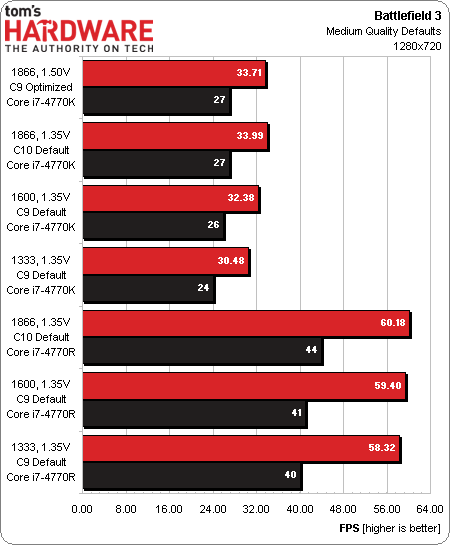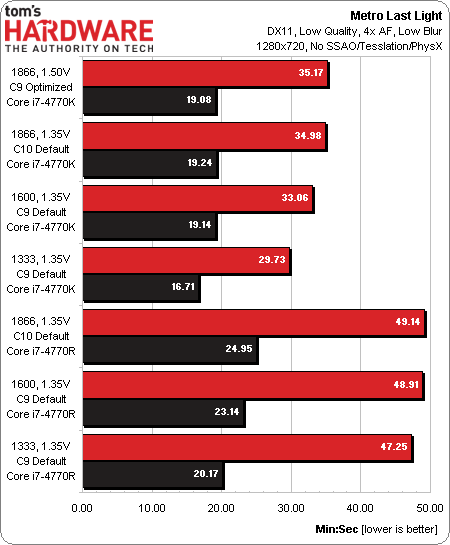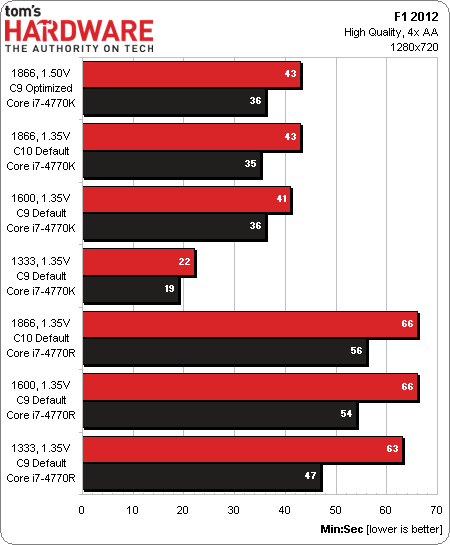Haswell And 1.35 V Memory: Three DDR3 SO-DIMM Kits, Tested
When it comes to memory, most of our focus is on the desktop and its replaceable CPUs. The mobile side typically moves slower. But Intel's Haswell architecture imposes interesting changes, and we saw fit to test SO-DIMMs down at their new 1.35 V ceiling.
Results: 3D Games
I chose 1280x720 for game testing because that resolution puts relatively little demand on our on-die GPUs and because it upscales nicely on 1920x1080 displays. I then increased the detail levels I was using to maximize my enjoyment of each title.
Faster memory boosts the Core i7-4770K's HD Graphics 4600 engine by around 11% in Battlefield 3; the Core i7--4770R's average FPS only rises by 3.2%. The big difference can be seen in minimum FPS, which picks up by 10%.
Far Cry 3 doesn’t need super-fast RAM, but it also doesn’t like DDR3-1333 on the weaker Core i7-4770K.
Would you believe it? A demanding title like Metro: Last Light actually runs on platforms with integrated graphics. Don’t let the Low quality preset fool you; the game still looks gorgeous. Faster memory helps where it matters most: the minimum frame rate figures.
We've often found F1 2012 to be limited by either CPU or DRAM performance. Of course, when you're relying on integrated graphics, that can hold you back, too. The HD Graphics 4600 engine's performance is crippled by anti-aliasing in this title. Unfortunately, the game looks pretty terrible at low resolutions with AA disabled. DDR3-1333 kneecaps the LGA 1150-based platform, while the Core i7-4770R with Iris Pro graphics 5200 cruises through as if it were a completely different technology.
Get Tom's Hardware's best news and in-depth reviews, straight to your inbox.
-
Jaroslav Jandek ReplyIt'll be more difficult to explain why the -4770R saw so much less benefit from higher data rates than the -4770K.
The R version has 128MB of L4 cache. At 1280x720, it is large enough for all index and vertex buffers and most textures. That is why main memory speed doesn't significantly affect Iris Pro 5200... -
InvalidError Having 128MB L4 cache certainly skews things around for IGP performance, no surprise there.Reply -
mouse24 Huh, fairly surprised I didn't know about the 1.35v requirement. What happens if you pop in 1.5v in there? Is this just a power savings thing or did intel really mess with their memory controller for laptops?Reply -
Isaiah4110 Wow! I know this article is about memory, but the game benchmark data for Iris Pro actually impresses me quite a bit!Reply -
Crashman Reply
Tell one of these companies that makes upgrade processors to solder the 4770R on an 1150 adapter :)12435372 said:Intel really should've made socketed cpus with Iris Pro
-
zodiacfml AMD must have been very envious with this Iris Pro having embedded 128MB of fast memory....which should be plenty useful for their AMD's APUs.Reply -
de5_Roy Reply
intel claims that the edram costs around $80. that'd jack the a10 6800k price over $200 only to benefit the igpu (possibly the same with gddr5). imo, the weaker cpu cores wouldn't benefit much, if at all. that'd make the apus of poor value and people will argue against the apus claiming you can have a faster configuration under $200 (e.g. core i3 4110/fx6300 + radeon 7770/7750) without requiring the edram. as for core i7 4770R (and other R skus) - it's way too expensive. afaik, brix pro is barebones, the whole pc might cost near $800-1000 fully configured.12436339 said:AMD must have been very envious with this Iris Pro having embedded 128MB of fast memory....which should be plenty useful for their AMD's APUs.




